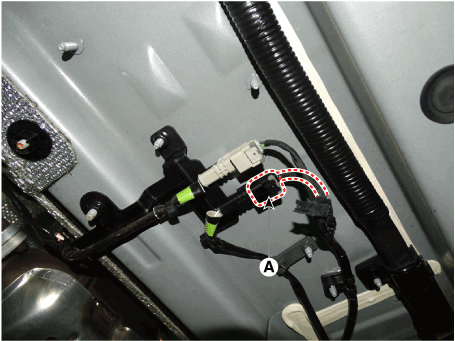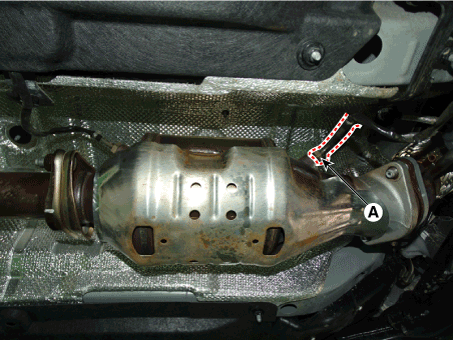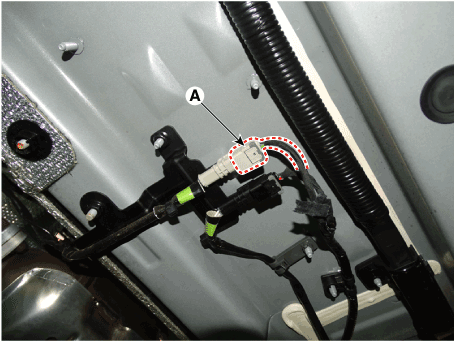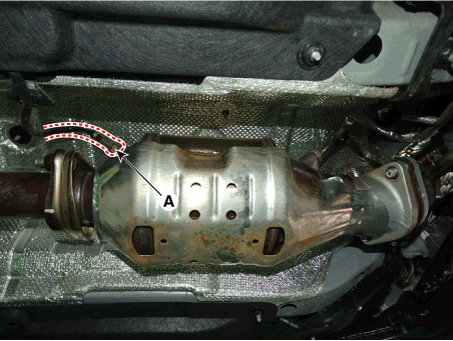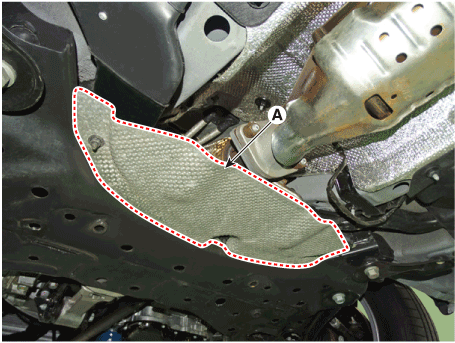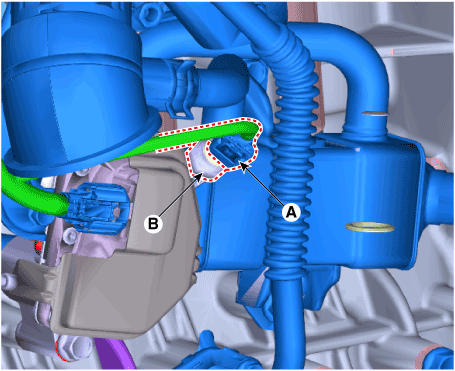Hyundai i-30: Engine Control System / Exhaust Gas Temperature Sensor (EGTS)
Hyundai i30 (PD) 2018-2025 Service Manual / Engine Control / Fuel System / Engine Control System / Exhaust Gas Temperature Sensor (EGTS)
Description and operation
| Description |
Exhaust Gas Temperature Sensor (EGTS) is installed on Gasoline Particulate Filter
(GPF) senses the temperature of exhaust gas flowing into. When pre-determined
engine condition is set, ECM burns soot gathered in GPF with exhaust gas. At
this time, the exhaust gas temperature is an important factor of engine condition
Exhaust Gas Temperature Sensor (EGTS) #1 (Front) [GPF Type]
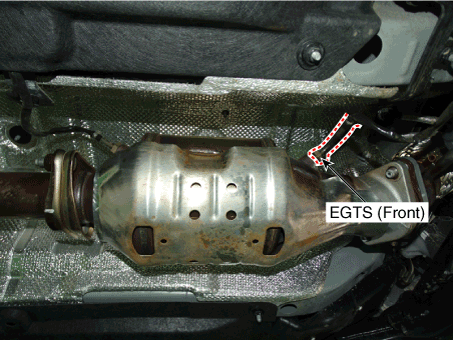
Exhaust Gas Temperature Sensor (EGTS) #2 (Rear) [GPF Type]
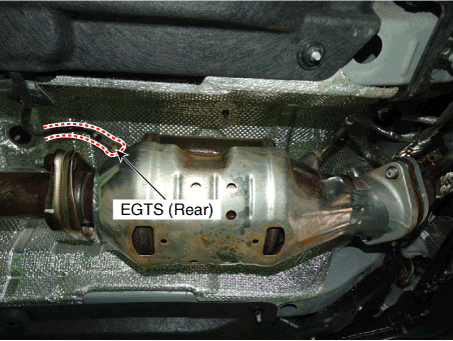
Exhaust Gas Temperature Sensor (EGTS)
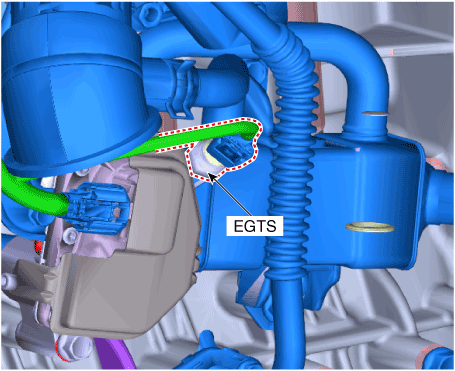
Specifications
| Specification |
Exhaust Gas Temperature Sensor (EGTS) #1, 2 [GPF Type]
▷ Type : Thermistor type
|
Temperature [°C (°F)] |
Resistance (kΩ) |
|
-40 (-40) |
0.17 |
|
0 (-32) |
0.201 |
|
100 (212) |
0.276 |
|
200 (392) |
0.35 |
|
300 (572) |
0.42 |
|
400 (752) |
0.489 |
|
500 (932) |
0.555 |
|
600 (1112) |
0.618 |
|
700 (1292) |
0.68 |
|
800 (1472) |
0.739 |
|
850 (1562) |
0.767 |
Exhaust Gas Temperature Sensor (EGTS)
▷ Type : Thermistor type
|
Temperature [°C (°F)] |
Resistance (kΩ) |
|
-40 (-40) |
120.1 - 140.6 |
|
-30 (-22) |
82.2 - 95.5 |
|
-20 (-4) |
57.9 - 66.8 |
|
-10 (14) |
41.8 - 47.9 |
|
0 (32) |
30.9 - 35.2 |
|
10 (50) |
23.3 - 26.4 |
|
20 (68) |
17.9 - 20.2 |
|
30 (86) |
14.0 - 15.7 |
|
40 (104) |
11.1 - 12.4 |
|
50 (122) |
8.92 - 9.91 |
|
60 (140) |
7.27 - 8.04 |
|
70 (158) |
5.99 - 6.60 |
|
80 (176) |
4.98 - 5.47 |
|
90 (194) |
4.19 - 4.58 |
|
100 (212) |
3.44 - 3.87 |
|
110 (230) |
3.03 - 3.29 |
|
120 (248) |
2.61 - 2.82 |
|
130 (266) |
2.26 - 2.44 |
|
140 (284) |
1.97 - 2.12 |
|
150 (302) |
1.73 - 1.85 |
|
160 (320) |
1.52 - 1.63 |
|
170 (338) |
1.35 - 1.44 |
|
180 (356) |
1.08 - 1.15 |
|
190 (374) |
1.07 - 1.14 |
|
200 (392) |
0.97 - 1.03 |
|
210 (410) |
0.86 - 0.93 |
|
220 (428) |
0.79 - 0.85 |
|
230 (446) |
0.72 - 0.77 |
|
240 (464) |
0.66 - 0.71 |
|
250 (482) |
0.60 - 0.65 |
|
260 (500) |
0.55 - 0.60 |
|
270 (518) |
0.51 - 0.55 |
|
280 (536) |
0.47 - 0.51 |
|
290 (554) |
0.44 - 0.47 |
|
300 (572) |
0.40 - 0.43 |
Schematic diagrams
| Circuit Diagram |
Exhaust Gas Temperature Sensor (EGTS) #1 (Front) [GPF Type]
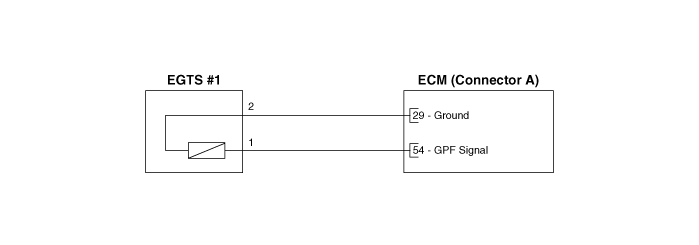
Harness Connector
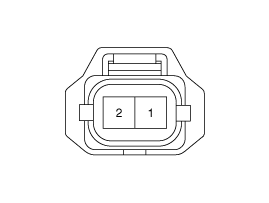
Exhaust Gas Temperature Sensor (EGTS) #2 (Rear) [GPF Type]
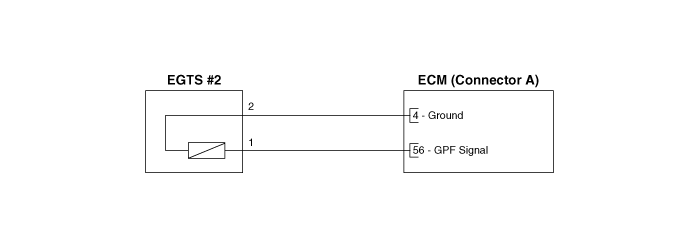
Harness Connector

Exhaust Gas Temperature Sensor (EGTS)
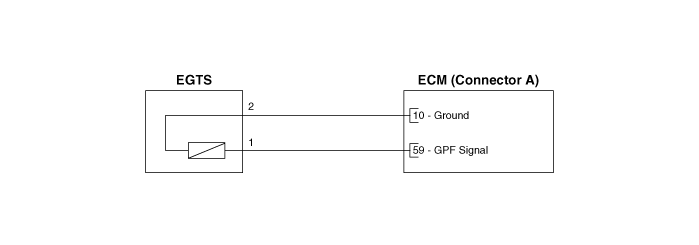
Harness Connector
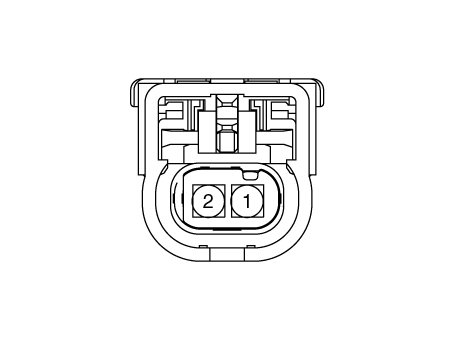
Repair procedures
| Inspection |
| 1. |
Turn ignition switch OFF.
|
| 2. |
Disconnect the connector of exhaust gas temperature sensors.
|
| 3. |
Measure resistance between sensor signal terminal and ground terminal.
|
| 4. |
Check that the resistance is within the specification.
|
| Removal |
Exhaust Gas Temperature Sensor (EGTS) #1 (Front) [GPF Type]
| 1. |
Turn the ignition switch OFF and disconnect the battery negative (-)
terminal.
|
| 2. |
Lift up the vehicle.
|
| 3. |
Remove the floor under cover.
|
| 4. |
Disconnect the egts connector (A).
|
| 5. |
Remove the egts sensor (A).
|
Exhaust Gas Temperature Sensor (EGTS) #2 (Rear) [GPF Type]
| 1. |
Turn the ignition switch OFF and disconnect the battery negative (-)
terminal.
|
| 2. |
Lift up the vehicle.
|
| 3. |
Remove the floor under cover.
|
| 4. |
Disconnect the egts connector (A).
|
| 5. |
Remove the egts sensor (A).
|
Exhaust Gas Temperature Sensor (EGTS)
| 1. |
Turn the ignition switch OFF and disconnect the battery negative (-)
terminal.
|
| 2. |
Remove the front muffler heat protector (A).
|
| 3. |
Disconnect the egts connector (A).
|
| 4. |
Remove the egts sensor (B).
|
| Installation |
|
| 1. |
Install in the reverse order of removal.
|
 Differential Pressure Sensor (DPS)
Differential Pressure Sensor (DPS)
Description and operation
Description
Differential Pressure Sensor (DPS) is measure the pressure difference of EGR
inlet and outlet...
 Differential Pressure Valve (DPV)
Differential Pressure Valve (DPV)
Description and operation
Description
Differential pressure valve (DPV) is control the pressure difference of EGR
inlet and outlet...
Other information:
Hyundai i30 (PD) 2018-2025 Owner's Manual: Fan speed control
Turn the knob to the right to increase the fan speed and airflow. Turn the knob to the left to decrease fan speed and airflow. Setting the fan speed control knob to the “0” position turns off the fan. NOTICE Operating the fan speed when the ignition switch is in the ON position could cause the battery to discharge...
Hyundai i30 (PD) 2018-2025 Service Manual: Rear Upper Arm
Repair procedures Removal 1. Loosen the wheel nuts slightly. Raise the vehicle, and make sure it is securelysupported. 2. Remove the rear wheel and tire (A) from the rearhub...
Categories
- Manuals Home
- 3rd Generation i30 Owners Manual
- 3rd Generation i30 Service Manual
- Shift-lock system. Shift-lock release
- Engine coolant
- EPB malfunction indicator
- New on site
- Most important about car
Turn signals and lane change signals
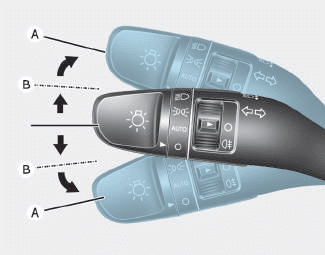
To signal a turn, push down on the lever for a left turn or up for a right turn in position (A). To signal a lane change, move the turn signal lever slightly and hold it in position (B).The lever will return to the OFF position when released or when the turn is completed.
Copyright © 2025 www.hi30.net

